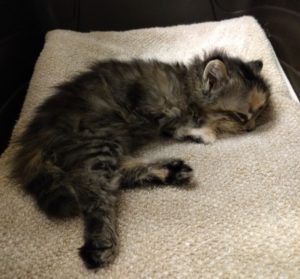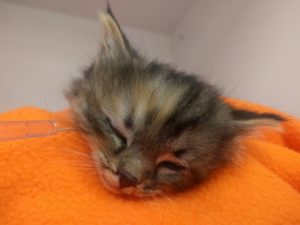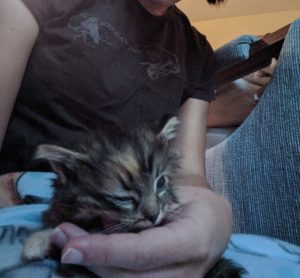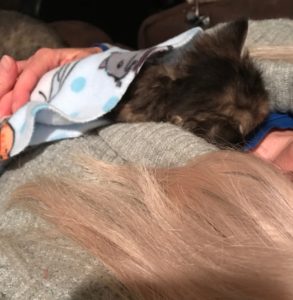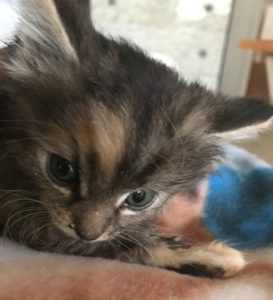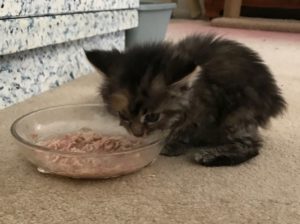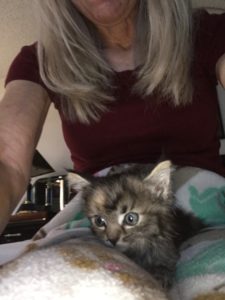Receiving the Call
When we received a call about a kitten that couldn’t walk and had a bloody nose, we knew we had to get them to a vet ASAP. Bleeding from the nose coupled with disorientation or being uncoordinated often meant heavy trauma, like being hit by a car or falling from a height. Wild Blue gets several calls a day about kitties in need, which means we’re constantly doing triage on which kitties can wait until later and which kitties need immediate attention. This kitten needed immediate attention- and she was on the way to an ER within 30 minutes of receiving that call.
Confirming the Situation
The pet ER confirmed that the little kitten (about 8 weeks) had suffered crush trauma- something had fallen on her from above and fractured her skull. Her head was swollen, she was pretty lethargic and didn’t have any motor control. Frankly, we weren’t sure she was going to make it. We kept her on supportive care in the ER for 18 hours and named her Florissa, so that if she didn’t survive, she’d have a name for her headstone.
A Difficult Choice
After 18 hours of hospitalization, we reassessed Florissa’s condition. She had eaten a little, moved a little, but hadn’t shown any signs of recovery and her red blood cell count was getting weird- indicating infection. We were told she had only a 50% chance to live, and that even if she did, she might permanently brain damaged. Sure, we could try expensive surgery to alleviate the swelling in her brain, but she probably wouldn’t survive the anesthetic (which can be very dangerous to kittens). In light of all that, the emergency care veterinarian recommended euthanasia. The thing is, Wild Blue opts for euthanasia only as a last resort, when the kitty is incurable and clearly suffering. Florissa seemed comfortable on the painkillers, and still had a 50% chance to recovery. We decided to place Florissa with an experienced foster that could do all the necessary things the ER was doing- fluids, medication, constant check ins, syringe feeding etc, and gamble on her will to fight. And, if she did pass, she would do so in the comfort of a home with someone tending to her and not in the chaos of an ER situation.
Foster Care
The first night, everything was quiet and unchanging…but the next day, Florissa started having seizures; an unsurprising side effect of having brain swelling. She spent several hours watched by Ponderosa Veterinary Clinic before the seizures subsided and she was cleared to return to the foster with some additional medications. We were all really nervous about her chances. Had we done the right thing? …thankfully, we got our answer the next day, when instead of just accepting a syringe feeding, she enthusiastically ate 5 mls of chicken baby food! She was fighting for her life, and we’d enabled her!
Every day since has been a slow and steady path to recovery– she started WALKING (at first only in circles to the right, indicating damage to her left lobe), she started cleaning herself, she started eating on her own from a shallow bowl…we’re finally comfortable talking about her, because we think Florissa’s case will be a triumph, rather than a tragedy.
If you appreciate what we do, even in the face of dire odds, consider making a donation. We’re all volunteers at Wild Blue, and taking on slim chance cases like Florissa’s (~$2,000) really drains our funding.

